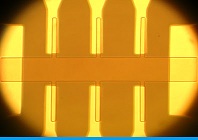Hybrid materials that change magnetism with small shifts in temperature hold immense potential for computer memory systems and transformers, according to a seminar at the forthcoming CWIEME Berlin exhibition.

A team of researchers led by Professor Ivan K. Schuller at the University of California, San Diego has developed a new breed of magnetic materials with profound implications for the electrical and electronics industries. Even without a magnetic field, these materials have the ability to change from insulators to conductors and vice versa within a very narrow temperature range – providing a new mechanism for controlling magnetism.
“Discovering new materials is not an easy business – and discovering materials that happen to have the exact properties you need for a certain application is practically impossible,” says Prof. Schuller. “Our approach is to combine two naturally-occurring materials, whose properties we already understand, to create a third material – a so-called hybrid with different and perhaps useful properties.”
Most recently, Prof. Schuller and his team have discovered that by combining thin layers of oxides, such as vanadium oxide, with magnetic materials such as cobalt, nickel or iron, they can create a structure that is remarkably responsive to heat. The oxide, typically an insulator, becomes more like the magnetic material and the magnetic material more like the oxide.
The properties of these magnetic oxide hybrids and their potential for both the electrical and electronics industries will be the subject of a seminar by Prof. Schuller at this year’s CWIEME Berlin, the world’s largest electrical manufacturing exhibition.
Although it is too early to predict exactly how these new magnetic materials will be used, Prof. Schuller sees two clear opportunities: in computer memory systems and in transformers.
The next generation of computer memory systems that are being developed use high temperatures generated by lasers to manipulate magnetic properties. Schuller’s sensitive magnetic oxide hybrids would eliminate the need for such high temperatures.
Magnetic oxide hybrids could also be used to build a replacement for current fault limiters in transmission lines in case of a lightning strike or power surge. Once the danger is over and the temperature returns to normal the power distribution system would automatically resume service.
“My team and I have been carrying out very basic research. We are not looking at applications at all – but the industry needs to understand where science is heading and its possible disruptive effects,” says Prof. Schuller. “I cannot say how this research will change our lives – that’s for the electrical engineers to decide – but I can guarantee that it will.”






